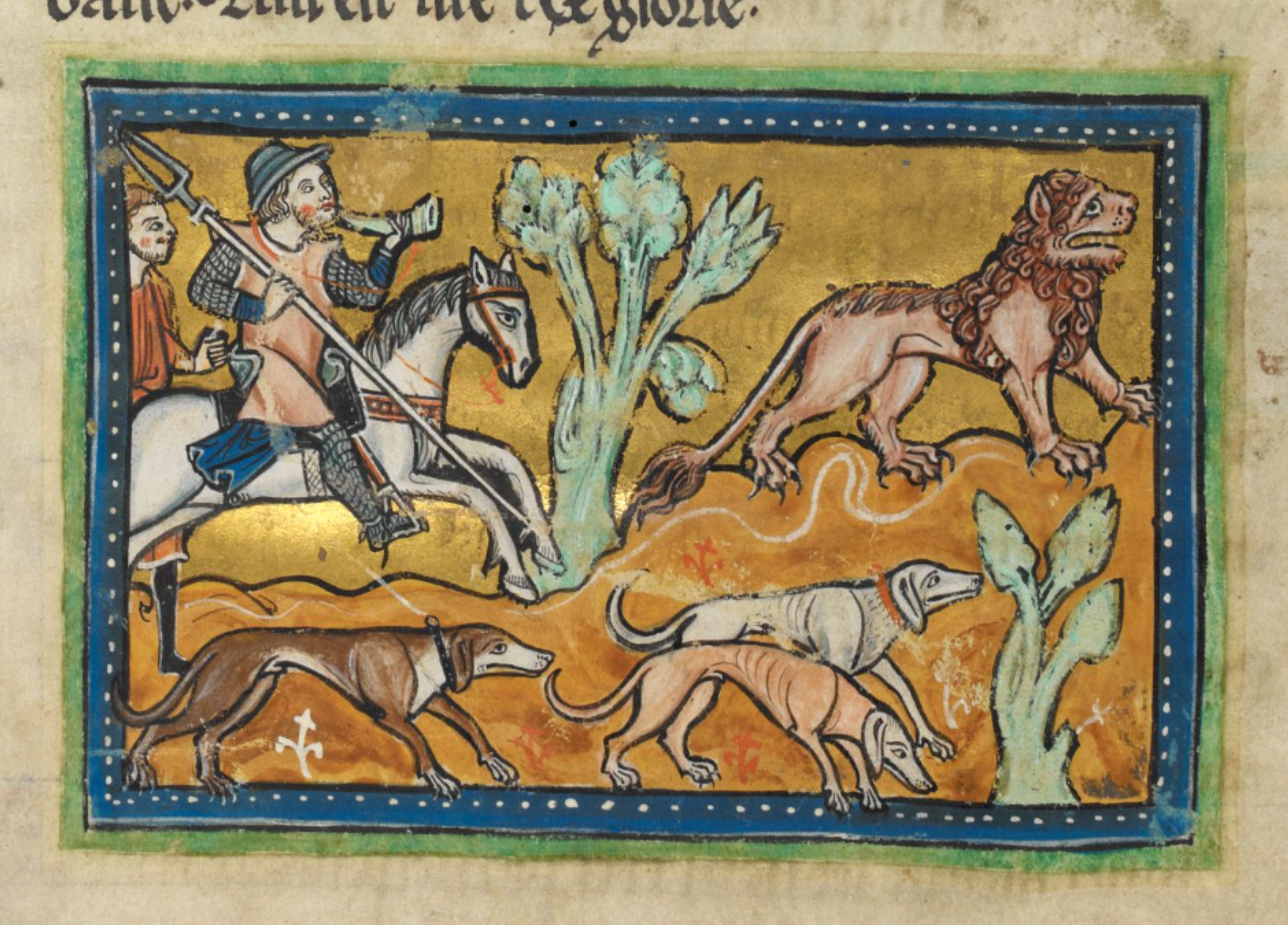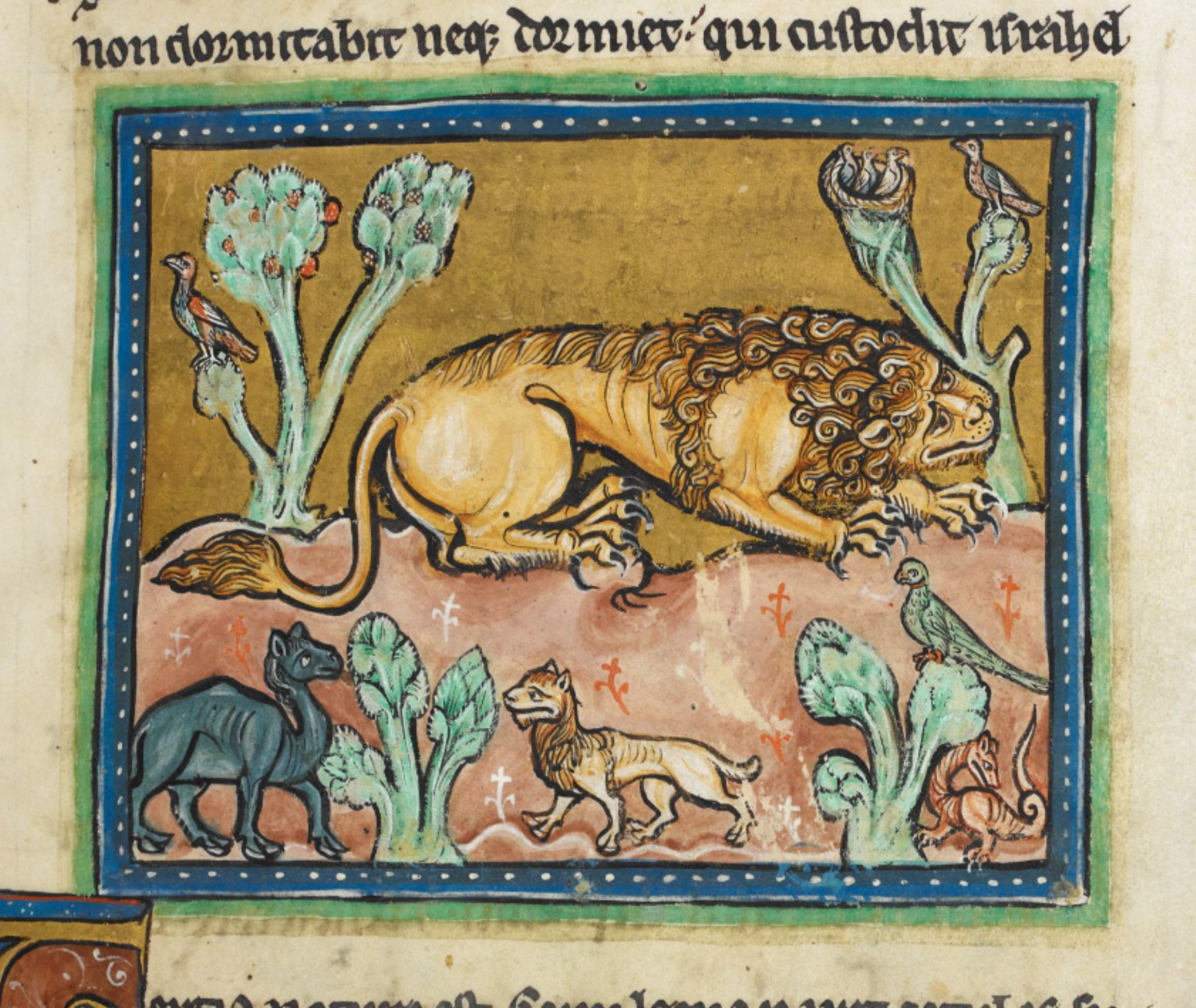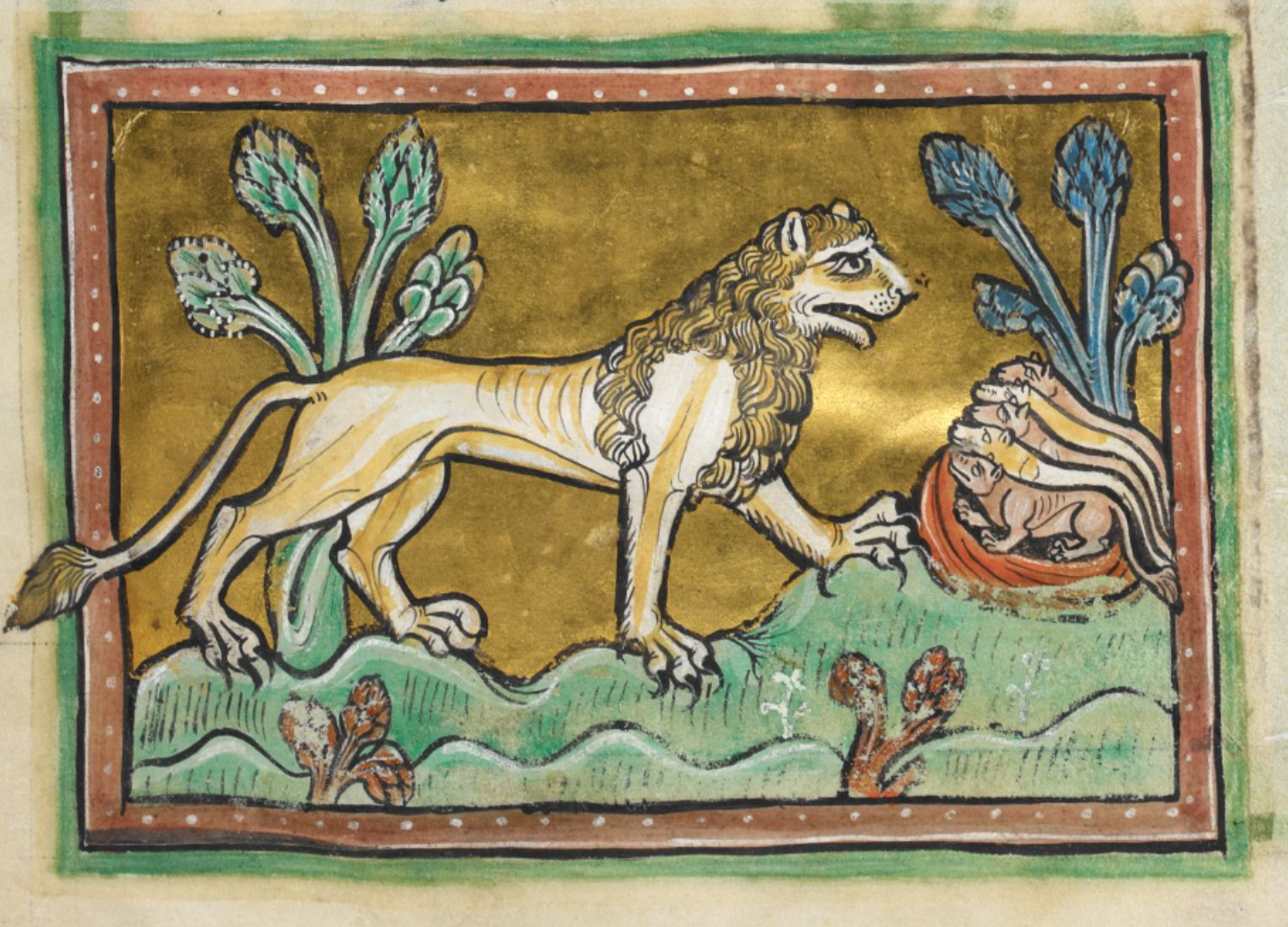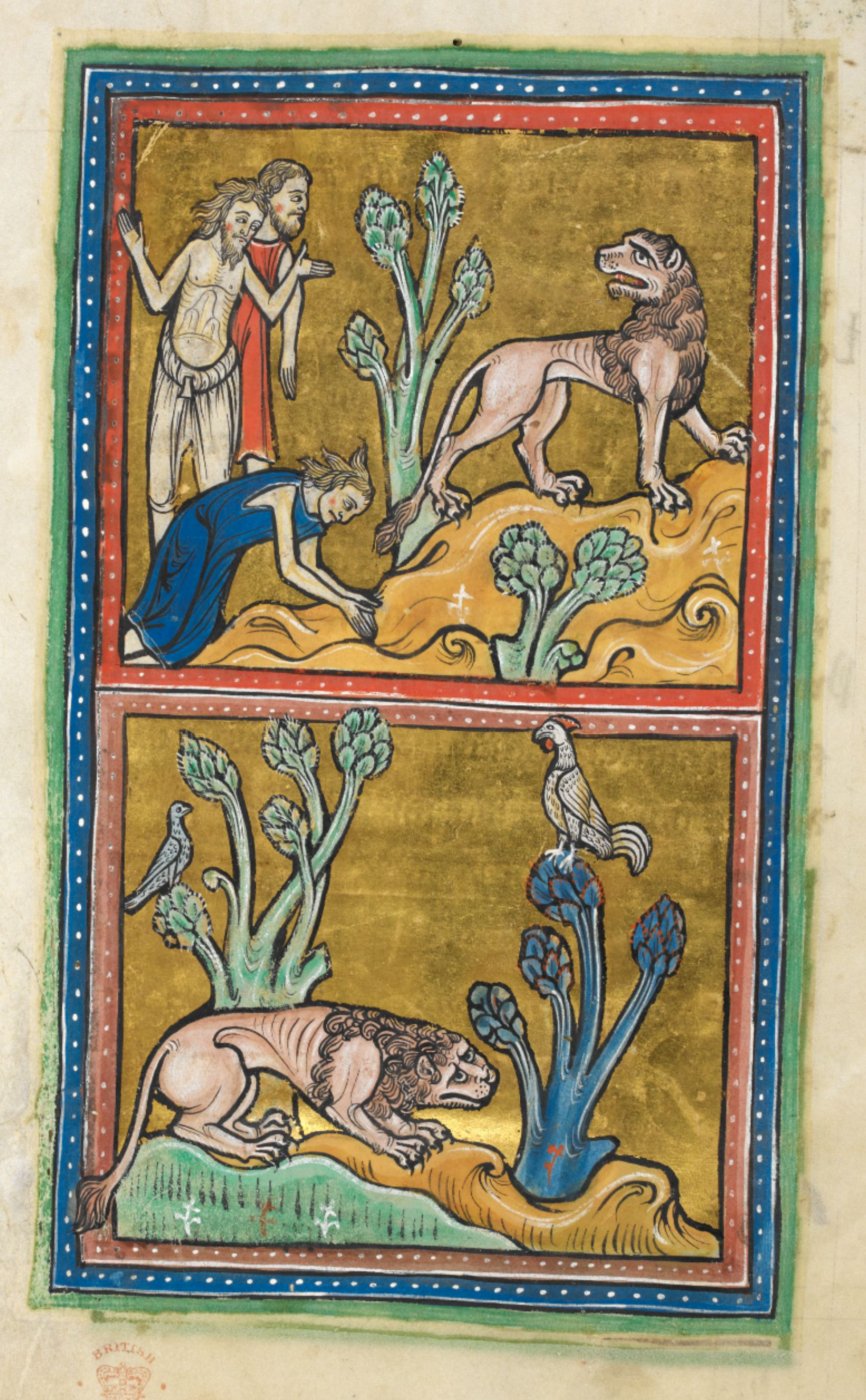Rochester Bestiary, circa 1230
Introduction
Dr Diane Heathe
The bestiary is a medieval book of beasts, in Latin a liber bestiarum or a bestiarium. In the medieval period (400-1500CE) ‘bestiary’ referred to a specific spiritual book that focused on aspects of animal traits in relation to the lessons they provided to people. There were many inter-related versions of the bestiary, in prose and in rhyme, in Latin and in the vernacular. The earliest and main version was the medieval Latin prose bestiary, which was based on a book called the Physiologus, written by monks who lived in the Egyptian desert around the third and fourth centuries. This is why the bestiary includes so many animals from Africa and the Near East. The bestiary allowed the ‘book’ of nature to be read and understood as part of divine creation, as the Book of Job explains:
ask now the beasts, and they shall teach thee: and the birds of the air, and they shall tell thee. Speak to the earth, and it shall answer thee: and the fishes of the sea shall tell. Who is ignorant that the hand of the Lord hath made all these things?
Job 12:7-9
This reading of nature became part of what has been called the ‘two books’ trope and was summed up by Alan of Lille (ca. 1128- ca. 1203/5) as
every creature of the world is for us like a book and a picture and a mirror as well.
Alain de Lille2
In its way of reading creation in spiritual terms, the bestiary was a standard text. Its approach linked the literal, allegorical, moral, and spiritual senses of the animal in what was called the ‘allegory of the fourfold senses’, or sensus spiritualis. The bestiary developed from scriptural teachings linked to the classical education of the trivium (grammar, rhetoric, and dialectic) and the quadrivium (arithmetic, music, geometry and astronomy). Such teachings sought to understand the Word of God in the Bible and in nature. It sought correspondence between creation and the mysteries of heaven that St Augustine discussed in his De Doctrina Christiana.3 These ideas were applied to animals in the bestiary, to stones in the lapidary, and to plants in the herbals.4 Yet there was also a practical element too, creatures, stones and plants were supposed to be described accurately, although drawing from written descriptions allowed artists creative licence – for example, who was to say how accurate an Elephant was when nobody had seen one (until Henry III was given one in the mid thirteenth century).
The bestiary is why we still think of the Lion as the king of beasts and why we say apprentices should be ‘licked into shape.’ The book was the main source of information on animals, particularly non-European animals, for centuries in the Middle Ages. Churches were full of allusions to stories from the bestiary, such as the Lion representing Christ, the Pelican pecking blood from its breast to revive its chicks, and the Dragon as a figure for evil.
Medieval stained-glass Dragon: Trinity Chapel, Canterbury Cathedral, credit: Professor Rachel Koopmans
While many bestiaries were unillustrated, some of the deluxe versions produced for wealthy monasteries and the nobility have sumptuous illuminations by professional artists using the most expensive pigments and often gilded. The Rochester Bestiary is one of the most beautiful of these superb medieval masterpieces and it is still being used as inspiration for artists of all ages today. Having this c. 800 year old priceless manuscript on display in the place where it was made is a terrific opportunity for people in Rochester to see for themselves their wonderful medieval heritage.
DEH
July 2023
Footnotes
1 Douay-Rheims trans. Vulgate.
2 Alain de Lille, De Incarnatione Christi Rhythmus Perelegans, PL 210, col. 579A, ‘Omnis mundi creatura/ Quasi liber et pictura/ Nobis est et speculum’ quoted in E. R. Curtius, European Literature and the Latin Middle Ages (1953), p. 319.
3 R. P. H. Green, De Doctrina Christiana, (1995) 1.2; J. Sailhamer, ‘The Classical and Medieval View of Scriptural Meaning’, The Meaning of the Pentateuch: Revelation, Composition and Interpretation (2009), p. 75-80; F. Ohly, Sensus Spiritualis (2005), p. 3.
4 See H. Lubac, Medieval Exegesis, (trans. 1998) 1, pp. 1-14; J. Ziolkowski, ‘Literary Genre and Animal Symbolism’, ed. by L. A. J. R. Houwen, Animals and the Symbolic in Mediaeval Art and Literature (1997), pp. 1-23, p. 9 describes St Augustine’s ideas as ‘codes of meaning.’
In Medieval Christian religion, the lion was sometimes associated with Christ in order to emphasise His power and authority over all His creation. Christ was seen as the saviour and the ruler. In revelation 5:5, Christ was called the Lion of Judah1, firstly because the lion was the symbol of the House of Judah and Jesus a descendent of the House of Judah, secondly because he was supposed to be a king and the lion symbolises the king of all beasts.
Lions were also a symbol of the resurrection of Christ after three days. Christians believed that lions’ cubs were born dead and remained as such for three days until their fathers breathed life into them.
They also symbolised purity and virginity owing to the lion’s habit of sleeping with its eyes open as a sign of vigilance and purity. The Virgin Mary was also perpetually pure and virgin and watched over humanity with care.
The text highlights the lion's merciful tendencies, demonstrating instances of restraint and compassion. Lions spare the fallen, refrain from overfeeding and exhibit a peculiar aversion to previous day's meals. Yet, they are not without vulnerabilities, as evidenced by their fear of certain creatures and susceptibility to venom.
Intriguingly, the narrative also touches upon mythical elements, such as the leontophones, small beasts whose ashes have lethal effects on lions. This juxtaposition of natural history with folklore adds layers of intrigue to the Bestiarium, making it a captivating exploration of the animal kingdom's complexities and mysteries.




